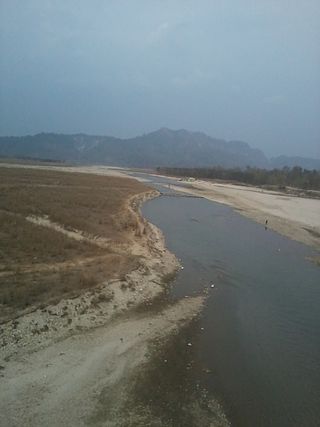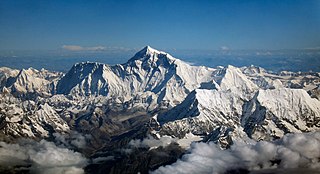Phakphok is a Village in Phakphokthum Rural Municipality of Ilam District in the Koshi Province of eastern Nepal. At the time of the 1991 Nepal census it had a population of 4,233 persons living in 734 individual households.

The Kankai River is a trans-boundary river flowing through the hills of Ilam and the plains of the Jhapa District in Nepal. It begins at the confluence of the Mai Khola and Deb Mai Khola rivers.

Koshi Province is the autonomous easternmost province adopted on 20 September 2015 by Constitution of Nepal. The province is rich in natural resources, tourist attractions, recreational activities, and natural beauty. The province covers an area of 25,905 km2 (10,002 sq mi), about 17.5% of the country's total area. With the industrial city of Biratnagar as its capital, the province includes major eastern towns of Birtamod, Sundar Haraincha, Damak, Dharan, Itahari, Triyuga Municipality and Mechinagar, and the Mount Everest, Kangchenjunga and Ama Dablam. Koshi River, the largest river of the nation, forms the province's western boundary. Under the First-past-the-post voting system issued by the Constituency Delimitation Commission, Nepal, the province hosts 28 parliamentary seats and 56 provincial assembly seats.

Modi River or Modi Khola is a tributary of Gandaki River in Parbat district of Nepal. It is a snow-fed perennial river originating from Annapurna Mountains and has a catchment area of 675 km². It meets the Kali Gandaki River at Modi Beni of Parbat District. The total length of the river is approximately 50km. The main tributaries of the Modi river are Bhurangdi Khola, Rati Khola, Pati Khola, Malyangdi Khola, Ghandruk Khola and Ambote Khola. The mean annual precipitation in the basin is approximately 2,700mm and 80% of the total annual rainfall occurs during the monsoon.
Andhi Khola Hydropower Station is a run-of-river hydro-electric plant located in Syangja District of Nepal. The flow from Andhi River, a tributary of Kali Gandaki River, is used to generate 9.4 MW electricity and annual energy of 68.38 GWh. The plant is owned and developed by Butwal Power Company Limited, an IPP of Nepal in technical help from UMN. The plant started generating electricity since 2052-01-08 BS. The generation licence will expire in 2101-12-30 BS, after which the plant will be handed over to the government. The power station is connected to 132 kV national grid through the substation at Rang Khola and sells electricity to Nepal Electricity Authority.
Puwa Khola Hydropower Station is a run-of-the-river hydro-electric plant located in Ilam District of Nepal. The flow from Puwa River, a tributary of the Mai Khola, is used to generate 6.2 MW electricity. The plant is owned and developed by Nepal Electricity Authority, a government-owned public company. The plant started generating electricity in 2060-12-22 BS. The generation licence would expire in 2101-12-30 BS, after which the plant would be handed over to the government. The power station is connected to the national grid.
Jogmai Khola Hydropower Station is a run-of-river hydro-electric plant located in Ilam District of Nepal. The flow from Jogmai River is used to generate 7.6 MW electricity. The plant is owned and developed by Sanvi Energy Pvt. Ltd., an IPP of Nepal. The plant started generating electricity from 2074-01-18BS. The generation licence will expire in 2104-12-28 BS, after which the plant will be handed over to the government. The power station is connected to the national grid and the electricity is sold to Nepal Electricity Authority.
Daraundi A Hydropower Station is a 6 MW run-of-river hydro-electric plant located on the Daraundi River in the Gorkha District of Nepal.
Daram Khola-A Hydropower Station is a run-of-the-river hydroelectricity plant located in Baglung District of Nepal. The flow from Daram River is used to generate 2.5 MW electricity.
Upper Puwa-1 Hydropower Station is a run-of-river hydro-electric plant located in Ilam District of Nepal. The flow from Puwa River, a tributary of Mai River, is used to generate 3 MW electricity. The design flow is 4.46 m3 (158 cu ft) per second and design head is 125 m (410 ft).
Upper Mai-C Hydropower Station is a 6.1 MW run-of-the-river hydro-electric plant located in Ilam District of Nepal. It is powered by water from the Mai Khola.
Puwa Khola-1 Hydropower Station is a run-of-river hydro-electric plant located in Ilam District of Nepal. The flow from Puwa River, a tributary of Mai River is used to generate 4 MW electricity.
Rudi A Hydropower Station is a run-of-river hydro-electric plant located in the Kaski District of Nepal that came into operation in 2019. The flow from the Rudi River is used to generate 8.8 MW electricity.
The Rudi River, or Rudi Khola is a river in Nepal, a left tributary of the Madi River.
The Daraudi River is a river in Nepal. It is a left tributary of the Marshyangdi river, which in turn joins the Trishuli River.

The Puwa River is a river in Nepal. It is a right tributary of the Mai Khola.
Super Mai Hydropower Station is a run-of-the-river hydro-electric plant located in Ilam District of Nepal. The flow from Mai River is used to generate 7.8 MW electricity.
Super Mai-A Hydropower Station is a run-of-the-river hydro-electric plant located in Ilam District of Nepal. The flow from Mai River is used to generate 9.6 MW electricity. The design head is 199.3 m.
Super Mai Khola Cascade Hydropower Station is a run-of-the-river hydro-electric plant located in Ilam District of Nepal. The flow from Mai River is used to generate 3.8 MW electricity.
Mai Khola Small Hydropower Station is a run-of-the-river hydro-electric plant located in Ilam District of Nepal. The flow from Mai River is used to generate 8 MW electricity. The plant is owned and developed by Himal Dolkha Hydropower Company Pvt Ltd, an IPP of Nepal.




